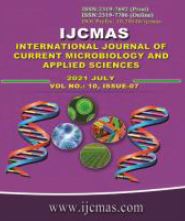


 National Academy of Agricultural Sciences (NAAS)
National Academy of Agricultural Sciences (NAAS)

|
PRINT ISSN : 2319-7692
Online ISSN : 2319-7706 Issues : 12 per year Publisher : Excellent Publishers Email : editorijcmas@gmail.com / submit@ijcmas.com Editor-in-chief: Dr.M.Prakash Index Copernicus ICV 2018: 95.39 NAAS RATING 2020: 5.38 |
Sesame (Sesamum indicum L.) is one of the important oilseed crops which are usually grown under rainfed condition on marginal lands in India. In Assam, the crop is grown in different parts of the state during summer and kharif season. The crop sesame is infected by several fungal, bacterial as well as phytoplasma diseases in the field grown in both the seasons, however, the kharif sesame which covers most of the sesame growing areas of the state often encountered by Phytophthora blight(Phytophthora parasitica var. sesame) due to frequent rainfall during the month of August-September which generally coincides with the early growth stage of the crop causing severe mortality of young seedlings as well as leaf blight in standing crops inflicting heavy yield losses. Considering the seriousness of the disease and the importance of the crop, particularly in the Upper Brahmaputra Valley Zone of Assam, an experiment was conducted during 2016-17 and 2017-18 to evaluate the best fungicide against the disease in the field. Fungicides like Matalaxyl + mancozeb, Copper oxychloride, Fosetyl-Al, Mancozeb and Chlorothalonil were tested to evaluate their effectiveness against Phytophthora blight of sesame in the field condition. Out of all the tested fungicides, Matalaxyl + mancozeb (0.20%) was found to be the most effective fungicide in reducing highest (64.17%) PDI over control followed by Fosetyl-Al (0.15%), Copper oxychloride(0.20%) and Mancozeb (0.20%) with 57.75 %, 49.49% and 44.84% reduction of PDI over control, respectively.
 |
 |
 |
 |
 |